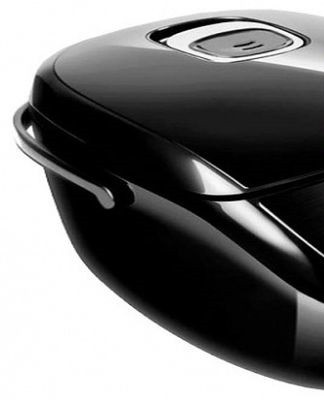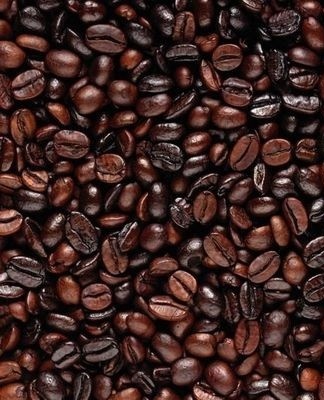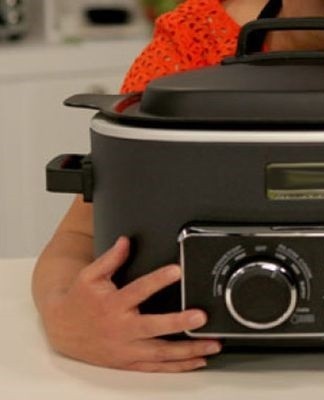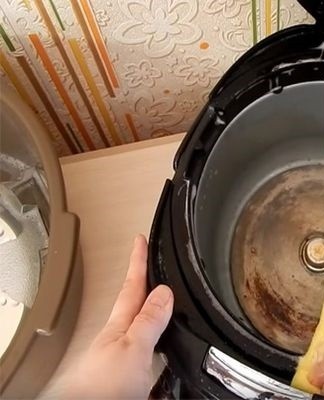Means and rules on how to quickly wash a multicooker at home
An indispensable assistant in everyday life is a multicooker, with each cooking it encounters such types of contamination as fat, oil, scale, stains from burnt food. Even with daily cleaning, a residual smell of cooked food or an unpleasant plastic smell may remain inside the appliance. How to properly and effectively wash your favorite multicooker, we will consider together.
What to wash?
In order to achieve the maximum quality of cleaning the multicooker and to remove unpleasant odors from third parties, it is necessary to wash all the main elements of the kitchen block.
Lid
This element is the most susceptible to the accumulation of dirt and odors.The rubber seal absorbs burnt food flavors that are hard to get rid of. It is more convenient when the lid is removable and can be washed separately from the body of the multicooker. The non-removable part must be cleaned after each cooking by wiping it with a soft cloth. Don't forget to clean the rubber gasket.
Different types of lids are used in models of Redmond multicookers, you should read the instructions when buying equipment.
bowl
Removable multi-cooker element with non-stick coating, which can be:
- ceramic;
- teflon.
Important! Ceramic coatings are not dishwasher safe.
Use mild cleaning agents and materials to remove dirt from non-stick coatings. It is necessary to wash the bowl after each use. Otherwise, the food debris will burn and the non-stick coating will lose its quality.
The surface can only be cleaned with warm water, no sharp temperature drops should be allowed - the coating may crack.
Steam valve
Located inside the lid and must be unscrewed to clean. First, the valve is flushed under the pressure of hot tap water. Clean the holes with a fine needle if they are dirty with food debris and grease.

If the steam tap is clogged, the food in the multicooker will spill over the top of the bowl and contaminate various elements of the kitchen block.
Humidity collector
Designed to collect excess moisture during steam generation and cooking. Often drops of oil, grease and food debris get into it along with water. The moisture trap is unscrewed and washed with soap solutions or gel-type dishwashing detergents.
A heating element
With careless use of the multicooker, pieces of food often fall on the heating element, which begin to burn and create an unpleasant odor. The heating plate can only be cleaned when it is switched off, when the heating element has cooled. Wet wipes or soft cotton cloths are generally used.
How to properly clean the bowl at home?
You can return the multicooker to its original appearance at home. It is important to know what tools and materials to use. Improper cleaning can cause irreparable damage.
What cannot be used?
Be especially careful when cleaning the non-stick coating. If the bowl is scratched, the food will burn, creating an unpleasant smell. The quality of dishes cooked in the multicooker will deteriorate.
Metal scrapers, brushes and sponges
To remove old dirt, it is not necessary to use metal brushes and sponges, they can leave scratches and damage the surface.

Aggressive detergents
As a rule, aggressive detergents are toxic. It is not safe to use them to clean the appliance in which food is prepared. Tiny chemical particles can remain in the bowl and end up in the food. In addition, household chemicals containing chlorinated components can corrode the non-stick coating.
Recommendations
To make the hostess happy with the result of washing your beloved assistant, you can use the following recommendations:
- If it is possible to unscrew the removable elements, do so.
- Never use powders or other products containing abrasive components.
- Avoid extreme temperatures, do not wash the multicooker in cold water.
- Once the washing is finished, wipe the kitchen unit.
The quality of cleaning the multicooker depends on the choice of detergent.
Liquid Dishwashing Gel
Light everyday dirt, deposits and grease can be removed perfectly with traditional liquid gel dishwashing detergent. After washing, it is important to completely rinse off product residues and wipe the multicooker with a dry soft cloth.
A sponge or soft cloth to wipe
When choosing a material for wiping, you should pay attention to the layer of the towel, cloth or sponge. There should be no pellets or hair on the surface of the multicooker, especially on the heating element. They can burn or get into the food. In addition, the towel should be soft so as not to leave micro-scratches and damage on the surface.

How to clean the bottom?
The bottom of the multicooker is cleaned when the heating element has cooled down. Insignificant dirt can be easily removed with a damp cloth. To remove burnt grease, you can use baking soda or citric acid, which has a double effect: it removes stubborn stains and unpleasant odors, and also disinfects the surface. The bottom can be cleaned with cotton balls and a soft, lint-free cloth.
How to clean the lid?
The multicooker lid is in close contact with the food to be cooked. Consists of steam valve, surface and rubber gasket. To properly clean the lid, the elements must be disconnected.
Removable
All removable elements of the multicooker are washed separately, cleaned of old dirt, rinsed thoroughly, wiped dry and collected.
Fixed
When washing a fixed lid, cover the main part of the kitchen appliance with polyethylene and tilt it over the sink. After carrying out all the manipulations, household appliances are rinsed and wiped dry.
Clean the trap
The moisture trap collects condensation and residual moisture after cooking. It must be washed after each cooking. The collected water is drained, and the container itself is washed with soapy water and wiped with a soft sponge.
How to clean the steam valve
The good taste and aroma of cooked dishes depends on the cleanliness of the steam valve (whether it is a Redmond or Polaris multicooker). If the steam valve is dirty, the steam does not find an exit from the body from the pan, cooked food "runs away" and often floods the heating element.

Food scraps and grease particles create an unpleasant odor inside the multicooker. First, the valve is washed in warm running water, then it is cleaned with a brush from dirt using citric acid, rinsed, wiped and put in place.
How to wash a stained case on the outside
From the outside, the multicooker is cleaned using household chemicals. Melamine sponges and scouring powders can be used. In order to remove fingerprints from chrome surfaces, you can use products containing ammonia.
Important! Do not wash the entire body of the multicooker under a tap with running water - an electrical short circuit may occur when you turn it on for the first time, if the water that gets inside does not have time to dry.
How to remove odors
The range of dishes prepared in a multicooker is huge. Today they are making fruit casserole, and tomorrow they are making fish soup. Each dish leaves a distinct smell that can affect the taste of the next serving.
Fish
A vinegar and water solution will help fight the fishy smell. Use 2 tablespoons of vinegar for 2 liters of water. This solution requires a steam cycle. You can use fruit vinegar for a pleasant scent after cleaning. After preventive boiling, rinse the bowl with warm water.
Musty or plastic smell
Any unpleasant musty smell in the bowl can be removed with citric acid. The algorithm of actions is the same as when using vinegar. For 1 liter of water, dissolve 1 tablespoon of acid and turn on the "steam" mode for 40 minutes. Then the multicooker is rinsed with warm water and wiped dry.
Very unpleasant
If, after cleaning the multicooker, an unpleasant pungent odor persists, use coffee beans to remove it. They should be left on a plate inside the bowl for 12 hours. Grains, like sponges, absorb the unpleasant aroma.

strong steadfast
Tincture of ginger root and lemon peel will help with persistent unpleasant odors inside the multicooker. The solution can be boiled "steamed" or simply wiped from the elements of kitchen equipment. After using the product, rinse the bowl.
Rules of care and prevention
To save time and effort in dealing with heavy soiling, it is important to systematically maintain the multicooker and carry out its preventive cleaning.
Cleaning after each cooking
After cooking, it is necessary to wash the equipment with a soapy solution: clean the tank, the steam valve, the rubber gasket, the lid and the humidity trap. Then the elements are rinsed and wiped dry.
Do not cover with a towel while cooking
The cooking temperature is set in the selected program.It is not necessary to close the multipot additionally. Air circulation is disturbed, the temperature changes. Food begins to splatter out of the bowl, into the steam valve and onto the heating element. Trust your household appliances, it is not recommended to use additional accessories.
Choose the right cleaning product
The time and effort spent on achieving the result depends on the chosen tool. Choose household chemicals with the lowest toxicity. It is better to give preference to natural remedies. Be sure to rinse residue from surfaces.
Do not leave cooked food inside the bowl
Violation of this rule leads to the formation of an unpleasant musty smell inside the multicooker. After cooking, the food is immediately transferred to a storage container or an ordinary pan. Even if the dish stood in the multicooker bowl for only 24 hours, it will not be possible to immediately get rid of the smell of the "old" food.

Do not use metal cutlery
Do not use a knife or other metal utensils to remove stubborn or burnt-on stains from the multicooker. Scratches will remain on the surfaces, the result will not please, the technique may be damaged.
What to do if the dish has sunk?
If the dish leaks during the cooking process, the following measures should be taken:
- Stop the cooking program and switch off the multicooker.
- Remove the bowl using oven mitts.
- Wait for the heating element to cool down.
- Clean the bottom with wet wipes.
- Rinse the sealing gum, the water trap and the steam valve.
- Wipe down all items.
- Continue cooking.
Often, food leaks during cooking due to a clogged steam valve or a violation of the amount of water in the dish being cooked.
Follow the recipe and clean the valve after each cooking.

Necessary measures to avoid contamination
To avoid serious contamination and the formation of a lingering unpleasant odor inside the bowl, you must:
- Clean the main elements regularly after each cooking, completely rinse the steam valve and the removable siphon under the tap.
- Store the multicooker with the lid slightly open and the steam valve open.
- Disinfect with citric acid or vinegar once a month.
- Place a piece of lemon zest in the bowl when the machine is idle.
- Follow the recipe when preparing dishes.
- Use natural and non-toxic products when washing.
- Do not damage the integrity of the non-stick coating.
When using household chemicals, use gloves and thoroughly rinse any cleaning agent residue from food contact surfaces. Do not store food in the bowl of the multicooker and never clean the surface that has not cooled down after work.
Compliance with the rules of regular cleaning and maintenance of kitchen appliances will allow the machine to work for a long time. Food cooked with a multicooker will be healthy and tasty.



